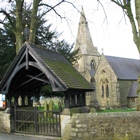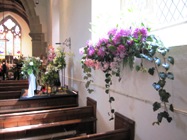
This page has specific information about Brackenfield Church, its history and some details about Brackenfield parish. For services, activities, events, contacts and directions, please follow the links above.
Flower Festival
 The final Brackenfield Well Dressing took place in 2017 but, having been a well-loved event for many years, it was decided to continue to hold a Flower Festival in Holy Trinity Church over the Spring Bank Holiday weekend.
The final Brackenfield Well Dressing took place in 2017 but, having been a well-loved event for many years, it was decided to continue to hold a Flower Festival in Holy Trinity Church over the Spring Bank Holiday weekend.
Brackenfield Church History
The original Trinity Chapel
The parish of Brackenfield, covering around 1500 acres and with a current population of about 150, originally formed a detached part of the ancient parish of Morton, some 2 miles to the east. A chapel of ease was built in Brackenfield on the hillside below Highoredish by the late thirteenth century and dedicated to the Holy Trinity. The ruins of “Trinity Chapel”, the remains of a sixteenth century replacement of the original chapel now hidden in trees, can be reached from a footpath and a village tradition developed of a pilgrimage to the Chapel on Trinity Sunday. This lapsed in recent years but was picked up again in 2010 when a church walk stopped in the chapel for a short service.
The medieval rood screen in the Chapel bore two armorial shields which indicated family alliances; firstly, the marriage between Hugh Willoughby (d.1558) of Risley and Margaret (d.1511) daughter of Thomas Molineaux of Hawton, Notts.; and secondly that between Hugh’s father Thomas Willoughby and Isabel daughter of John Bradburne of Hulland. By the middle of the fourteenth century the Willoughbys of Risley had succeeded the Heriz family as lords of Brackenfield under the Deincourts of Morton, and they continued to own the land for the following two centuries. It seem likely from this that Trinity Chapel was re-built by Hugh Willoughby of Risley who was a Sergeant -at-Arms to King Henry VIII, early in the sixteenth century; and indeed it may well have been built as a memorial to his wife Margaret who died in 1511.
The Chapel was dependent on Morton and the rectors of Morton held services there from time to time. A few baptisms and marriages are recorded at Trinity Chapel, but all burials took place at Morton. In 1758 the Chapel was augmented by Queen Anne’s Bounty and became a separate benefice with the rectors of Morton as patrons, but in 1844 Brackenfield was made into a separate parish. In 1856-7 a new parish church, also dedicated to the Hoy Trinity, was built in a more convenient village location and the old chapel was abandoned.
The new Holy Trinity Church
 The foundation stone of Holy Trinity Church, Brackenfield, was laid in 1856 by Mrs Ellen Turbutt , wife of Gladwin Turbutt of Ogston Hall, who gave the site for the new church and a considerable donation towards the cost. The church, designed by architect Thomas C. Hine of Nottingham, consisted of chancel, nave and north aisle built in the Decorated style for a cost of £1,300. Three years later, Gladwin Turbutt added the north-west tower for the bells. The small “Crispin Chapel” to the north of the chancel, with the Turbutt family vault beneath, was added after the death in 1872 of Gladwin Turbutt, who is buried with his wife in the vault. The interior fittings in the church are mostly Victorian, the floor of the chancel being covered with Minton tiles. Historically, the most interesting item within the church is the medieval traceried rood screen which was removed in 1881 from the then disused Trinity Chapel. The screen consists of a central doorway with crudely carved open arcading on both sides which had to be substantially restored; details of only one of the armorial shields was restored the other being left blank.
The foundation stone of Holy Trinity Church, Brackenfield, was laid in 1856 by Mrs Ellen Turbutt , wife of Gladwin Turbutt of Ogston Hall, who gave the site for the new church and a considerable donation towards the cost. The church, designed by architect Thomas C. Hine of Nottingham, consisted of chancel, nave and north aisle built in the Decorated style for a cost of £1,300. Three years later, Gladwin Turbutt added the north-west tower for the bells. The small “Crispin Chapel” to the north of the chancel, with the Turbutt family vault beneath, was added after the death in 1872 of Gladwin Turbutt, who is buried with his wife in the vault. The interior fittings in the church are mostly Victorian, the floor of the chancel being covered with Minton tiles. Historically, the most interesting item within the church is the medieval traceried rood screen which was removed in 1881 from the then disused Trinity Chapel. The screen consists of a central doorway with crudely carved open arcading on both sides which had to be substantially restored; details of only one of the armorial shields was restored the other being left blank.
Bells
Gladwin Turbutt completed the church with the north-east tower in 1860 and hung three bells from Taylor & Son of Loughborough there. An additional three bells from the Taylor Foundry were added when the tower and spire were repaired in 2001, providing a very ringable six.
Priests of Brackenfield
The first priest-in-charge of the newly formed parish of Brackenfield was the Revd James Rushton, who lived in Shirland and held the benefice from 1845-51, being succeeded by the Revd Edward Parker (1851-2). From 1853-7 the Revd Thomas Openshaw was priest-in-charge and from July 1857 the Revd Charles H. Leacroft took up his duties as the first vicar of Brackenfield. Three years later a vicarage was built and he was able to reside in the parish – a highly esteemed and much loved figure - until his death in 1899; he is buried just outside the chancel east window. (The Brackenfield vicarage, becoming redundant, was sold in 1983.)
The parish of Brackenfield lost its independence in 1923 and, following various parochial reorganisations, it is now part of the United Benefice of Ashover and Brackenfield with Wessington and falls within the Ministry and Mission Area of Ashover, Brackenfield, Handley and Wessington known as the Amber Churches.
